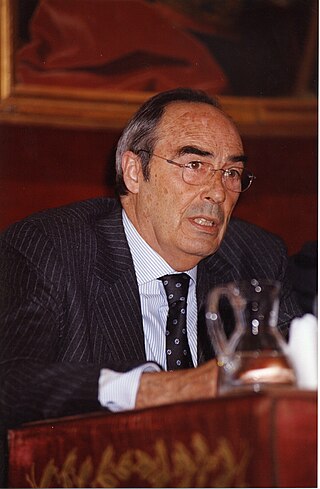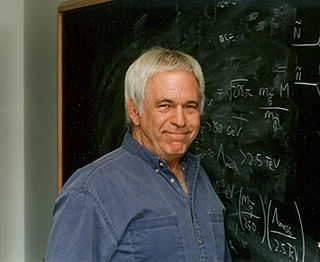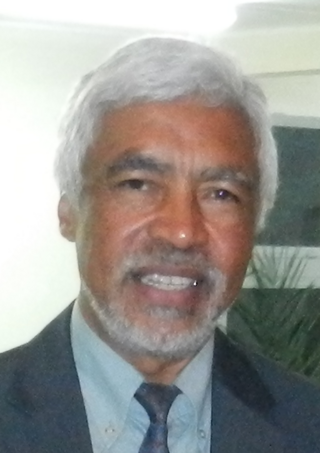Related Research Articles
In physics, string theory is a theory that attempts to merge quantum mechanics with Einstein’s general theory of relativity. The theory puts forth the premise of the material universe being made of tiny one-dimensional “strings”, rather than the more conventional approach in which they are modeled as zero-dimensional point particles. String theory envisions that a string undergoing a particular mode of vibration corresponds to a particle with definite properties such as mass and charge.
Supersymmetry is a theoretical framework in physics that suggests the existence of a symmetry between particles with integer spin (bosons) and particles with half-integer spin (fermions). It proposes that for every known particle, there exists a partner particle with different spin properties. There have been multiple experiments on supersymmetry that have failed to provide evidence that it exists in nature. If evidence is found, supersymmetry could help explain certain phenomena, such as the nature of dark matter and the hierarchy problem in particle physics.
In theoretical physics, twistor theory was proposed by Roger Penrose in 1967 as a possible path to quantum gravity and has evolved into a widely studied branch of theoretical and mathematical physics. Penrose's idea was that twistor space should be the basic arena for physics from which space-time itself should emerge. It has led to powerful mathematical tools that have applications to differential and integral geometry, nonlinear differential equations and representation theory, and in physics to general relativity, quantum field theory, and the theory of scattering amplitudes. Twistor theory arose in the context of the rapidly expanding mathematical developments in Einstein's theory of general relativity in the late 1950s and in the 1960s and carries a number of influences from that period. In particular, Roger Penrose has credited Ivor Robinson as an important early influence in the development of twistor theory, through his construction of so-called Robinson congruences.

In mathematics, p-adic analysis is a branch of number theory that deals with the mathematical analysis of functions of p-adic numbers.
Hadronization is the process of the formation of hadrons out of quarks and gluons. There are two main branches of hadronization: quark-gluon plasma (QGP) transformation and colour string decay into hadrons. The transformation of quark-gluon plasma into hadrons is studied in lattice QCD numerical simulations, which are explored in relativistic heavy-ion experiments. Quark-gluon plasma hadronization occurred shortly after the Big Bang when the quark–gluon plasma cooled down to the Hagedorn temperature when free quarks and gluons cannot exist. In string breaking new hadrons are forming out of quarks, antiquarks and sometimes gluons, spontaneously created from the vacuum.
Montonen–Olive duality or electric–magnetic duality is the oldest known example of strong–weak duality or S-duality according to current terminology. It generalizes the electro-magnetic symmetry of Maxwell's equations by stating that magnetic monopoles, which are usually viewed as emergent quasiparticles that are "composite", can in fact be viewed as "elementary" quantized particles with electrons playing the reverse role of "composite" topological solitons; the viewpoints are equivalent and the situation dependent on the duality. It was later proven to hold true when dealing with a N = 4 supersymmetric Yang–Mills theory. It is named after Finnish physicist Claus Montonen and British physicist David Olive after they proposed the idea in their academic paper Magnetic monopoles as gauge particles? where they state:
There should be two "dual equivalent" field formulations of the same theory in which electric (Noether) and magnetic (topological) quantum numbers exchange roles.
In theoretical physics in general and string theory in particular, the Kalb–Ramond field, also known as the Kalb–Ramond B-field or Kalb–Ramond NS–NS B-field, is a quantum field that transforms as a two-form, i.e., an antisymmetric tensor field with two indices.
Sze-Hoi Henry Tye is a Chinese-American cosmologist and theoretical physicist most notable for proposing that relative brane motion could cause cosmic inflation as well as his work on superstring theory, brane cosmology and elementary particle physics. He had his primary and secondary school education in Hong Kong. Graduated from La Salle College. He received his B.S. from the California Institute of Technology and his Ph.D. in physics from the Massachusetts Institute of Technology under Francis Low. He is the Horace White Professor of Physics, Emeritus, at Cornell University and a fellow of the American Physical Society. He joined the Hong Kong University of Science and Technology in 2011 and was the Director of HKUST Jockey Club Institute for Advanced Study during 2011-2016.

Francisco José Ynduráin Muñoz was a Spanish theoretical physicist. He founded the particle physics research group that became the Department of Theoretical Physics at the Autonomous University of Madrid, where he was a Professor. He was described by his colleagues as "a scientist that always searched for excellence in research".
In astronomy, optics and particle physics, the Bose–Einstein correlations refer to correlations between identical bosons.

Gordon Leon Kane is Victor Weisskopf Distinguished University Professor at the University of Michigan and director emeritus at the Leinweber Center for Theoretical Physics (LCTP), a leading center for the advancement of theoretical physics. He was director of the LCTP from 2005 to 2011 and Victor Weisskopf Collegiate Professor of Physics from 2002 - 2011. He received the Lilienfeld Prize from the American Physical Society in 2012, and the J. J. Sakurai Prize for Theoretical Particle Physics in 2017.

Riccardo Barbieri is an Italian theoretical physicist and a professor at the Scuola Normale Superiore di Pisa. He has written more than two hundred research papers in the field of theoretical elementary particle physics, and has been particularly influential in physics beyond the Standard Model.

Augusto Sagnotti is an Italian theoretical physicist at Scuola Normale.

Stephan Narison is a Malagasy theoretical high-energy physicist specialized in quantum chromodynamics (QCD), the gauge theory of strong interactions. He is the founder of the Series of International Conferences in Quantum Chromodynamics (QCD-Montpellier) and of the Series of International Conferences in High-Energy Physics (HEPMAD-Madagascar).
Peter Christopher West, born on 4 December 1951, is a British theoretical physicist at King's College, London and a fellow of the Royal Society.
Claus Kalevi Montonen is a Finnish theoretical physicist, most known for his work with British physicist David Olive in proposing the Montonen–Olive duality.
In quantum chromodynamics, heavy quark effective theory (HQET) is an effective field theory describing the physics of heavy quarks. It is used in studying the properties of hadrons containing a single charm or bottom quark. The effective theory was formalised in 1990 by Howard Georgi, Estia Eichten and Christopher Hill, building upon the works of Nathan Isgur and Mark Wise, Voloshin and Shifman, and others.
Paul Stephen Aspinwall is a British theoretical physicist and mathematician, who works on string theory and also algebraic geometry.
Michael Dine is an American theoretical physicist, specializing in elementary particle physics, supersymmetry, string theory, and physics beyond the Standard Model.
Generalized uncertainty principle — collective name for hypothetical generalizations uncertainty principle, which take into account the influence of gravitational interactions on the maximum achievable accuracy of measuring physical quantities.
References
- ↑ Volovich, I. V. (1987-06-01). "p-adic space-time and string theory". Theoretical and Mathematical Physics. 71 (3): 574–576. Bibcode:1987TMP....71..574V. doi:10.1007/bf01017088. ISSN 0040-5779. S2CID 119936152.
- ↑ Freund, Peter G.O.; Witten, Edward (1987). "Adelic string amplitudes". Physics Letters B. 199 (2): 191–194. Bibcode:1987PhLB..199..191F. doi:10.1016/0370-2693(87)91357-8.
- ↑ Marinari, Enzo; Parisi, Giorgio (1988-03-24). "On the p-adic five-point function". Physics Letters B. 203 (1–2): 52–54. Bibcode:1988PhLB..203...52M. doi:10.1016/0370-2693(88)91569-9.
- ↑ Freund, Peter G. O. (2006-03-29). "p‐Adic Strings and Their Applications". AIP Conference Proceedings. 826 (1): 65–73. arXiv: hep-th/0510192 . Bibcode:2006AIPC..826...65F. doi:10.1063/1.2193111. ISSN 0094-243X. S2CID 119086848.
- ↑ Khrennikov, Andrei (2009). Interpretations of probability (second ed.). Berlin: Walter de Gruyter. ISBN 9783110213195. OCLC 370384640.
- ↑ Dimitrijevic, D.d.; Djordjevic, G.s.; Nesic, Lj. (2008-04-18). "Quantum cosmology and tachyons". Fortschritte der Physik. 56 (4–5): 412–417. arXiv: 0804.1328 . Bibcode:2008ForPh..56..412D. doi:10.1002/prop.200710513. ISSN 1521-3978. S2CID 118417071.
- ↑ Dragovich, Branko; Rakić, Zoran (2010-12-01). "Path integrals for quadratic lagrangians on p-adic and adelic spaces". P-Adic Numbers, Ultrametric Analysis, and Applications. 2 (4): 322–340. arXiv: 1011.6589 . doi:10.1134/s2070046610040060. ISSN 2070-0466. S2CID 119297562.
- ↑ Vladimirov, V. S.; Volovich, I. V.; Zelenov, E. I. (1994). P-adic analysis and mathematical physics. Singapore: World Scientific. ISBN 9789814355933. OCLC 841809611.
- ↑ Djordjevic, Goran S.; Dragovich, Branko (2000-05-26). "On p-Adic Functional Integration". arXiv: math-ph/0005025 .
- ↑ Dragovich, Branko (1995-06-30). "Adelic harmonic oscillator". International Journal of Modern Physics A. 10 (16): 2349–2365. arXiv: hep-th/0404160 . Bibcode:1995IJMPA..10.2349D. doi:10.1142/s0217751x95001145. ISSN 0217-751X. S2CID 18786418.